Ijraset Journal For Research in Applied Science and Engineering Technology
- Home / Ijraset
- On This Page
- Abstract
- Introduction
- Conclusion
- References
- Copyright
Progression of M30 Strong on Banana Leaf Ash & E-Glass Fibre Infused in Cement
Authors: Narla Sasikala, Vanam Sameer Kumar
DOI Link: https://doi.org/10.22214/ijraset.2024.63625
Certificate: View Certificate
Abstract
In the context of a lack of fabric in concrete production, particularly in India where rapid infrastructure development has led to increased construction activities, the adoption of environmentally friendly practices is essential. India, renowned for its exceptional cement production worldwide, is now grappling with issues posed by the widespread Covid-19 pandemic, which is significantly disrupting the growth of the construction industry. This has led to neighbouring lockdowns and shortages in texture. The massive amounts of banana waste thrown out in India emit toxic quantities of carbon dioxide and methane gas into the atmosphere. Banana leaf ash may be produced after the bananas have been harvested. One possible use for the agriculture waste known as BANANA LEAF ASH (BLA) is to reduce the amount of cement needed to build concrete. E-GF stands for \"ELECTRONIC-GLASS FIBER,\" which might refer to a material made up of many little glass filaments. In addition to increasing the material\'s flexural, ductile, and affect properties, these strands fulfil a function similar to the strengthening steel present in traditional reinforced concrete. This Paper talks about maintain the variable frequency to makeup BLA with cement 0%, 2.5%, 5%, 7.5%, 10% & 12.5% & EGF with constant frequency of 3%. Moreover the comparison is held with proxy blends like 0%BLA+0%EGF, 2.5%BLA+3%EGF, 5%BLA+3%EGF, 7.5%BLA+3%EGF, 10%BLA+3%EGF & 12.5%BLA+3%EGF. BANANA LEAF ASH and E-GLASS FIBER together provide a sustainable and strength-enhancing solution for concrete. Seeing how cutting-edge materials may revolutionize building methods is fascinating.
Introduction
I. INTRODUCTION
A. Demonstration over Switching materials in Concrete
The cement and concrete industries have pledged to achieve net carbon neutrality by 2050. During the process of manufacturing Portland cement clinker, a significant amount of greenhouse gas emissions (GHG) are produced. These emissions are associated with the production of concrete. To reduce the carbon footprint of concrete, there are two primary methods that may be employed:
- Prevention
Objective: Minimize the total cement content per unit volume of concrete.
Implementation:
a. Mix Optimization: Change the concrete mix to increase the volume and minimize the concentration of cementitious ingredients and keep cool and fresh.
b. Performance-Based Design: Design concrete based on performance rather than supporting smaller cementitious components.
2. Substitution
a. Purpose: To partially or completely replace Portland cement with another material.
b. Materials: Supplementary Cementitious Materials (SCM): Examples include fly ash, slag, and silica fume. This paper is involved with two new materials like BANANA LEAF ASH (BLA) & E-GLASS FIBER (EGF)
c. Alternative Cementitious Materials (ACM) are a novel alternative to traditional concrete.
d. Alternative SCM (ASCM): A new resource that works with current infrastructure.
3. New Materials Criteria
a. Compatibility: Must have experience with cement distribution infrastructure and SCM.
b. Use: Perfect for processing, shipping, and batch processing.
c. Performance factors include strength, duration, and action duration.
d. Competitive pricing: inexpensive.
e. Adoption requires new materials to be competitive in price.
f. Importantly, economic viability and environmental advantages must be balanced
B. Why Banana Leaf Ash (BLA) is enrolled in concrete fill in?
Banana leaf ash has attracted attention as a sustainable option in concrete manufacturing. Let's examine why it is picked and its benefits:
- Use of garbage: India generates a substantial quantity of agricultural waste, including banana leaves. These leaves are generally thrown aside, producing environmental difficulties.
- Banana leaf ash gives a possibility to utilize this waste productively. By burning dry banana leaves and collecting the ash, we generate a valuable substance.
- Pozzolanic reaction: Banana leaf ash produces a pozzolanic reaction comparable to cement.
- Used as a partial replacement for cement, it enhances the strength of concrete.
- Environmental benefits: The use of banana leaf ash eliminates the requirement for conventional cement since its manufacturing process has a substantial environmental effect.
- By substituting some of the cement with banana leaf ash, we assist decrease waste and safeguard the environment.
C. How come the Purpose of opting the E-Glass Fibre (EGF) in Concrete?
A composite material called Glass Fibre Reinforced Concrete (GFRC) blends the flexibility of fiberglass with the strength of concrete.
- Glass: To strengthen and reinforce the concrete matrix, tiny individual glass fibers are woven throughout. Usually alkaline, these fiber’s work well with concrete mixtures.
- Weatherability and Durability Fiberglass’s strong qualities mixed with concrete's endurance make GFRC perfect for both interior and outdoor applications. It resists environmental contaminants, UV radiation, and severe weather.
D. Parentage of BANANA LEAF ASH (BLA) & E-GLASS FIBRE (EGF) :
BLA extraction includes the following points:
- Collect Banana Leaves: Get new banana clears out. These can be from different banana generation ranches or neighborhood banana trees. Dried the leaves within the sun for almost 30 days
- Burn the Clears out: Burn the dried banana takes off in an open-air environment. The buildup cleared out after burning is called banana leaf fiery debris.
- Refine the Cinder (Discretionary): On the off chance that vital, utilize a ball process to assist refine the banana leaf cinder for around 30 minutes.
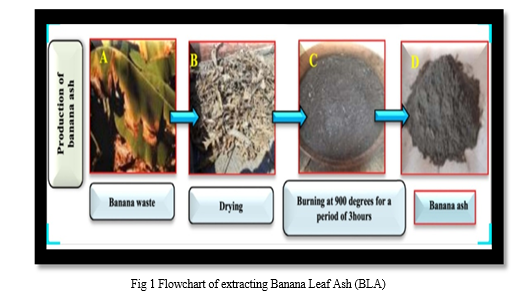
EGF extraction includes the following points:
- Raw Fabric Extraction: The process begins with the extraction and/or preparation of raw materials used to create glass, these raw materials often includes sand made of silica SiO2.
- Melting and Refining: The raw ingredients are heated to high temperatures roughly 1720°C or 3128°F in a heater.Glass flow is supported by channels that divide the heater into several sections. The initial region receives the most, since here is where dissolution occurs and consistency is increased, including bubble evacuation. At that moment, the glass is flowing liquid and enters the refiner, where it cools to 1370°C (2500°F).
- Glass Fibre Drawing: With the use of specialist equipment, the liquid glass is drawn into tiny strands. At that moment, these strands undergo encouraged handling.
- Chemical Folio Application (Optional): The fibers may be joined to a temporary chemical cover.This reduces scraped area and breakages by enabling the strands to be bent and coiled.2.
- Final Products: The glass strands that are supplied may be used for a variety of purposes, such as reinforcement in composite materials, covering, materials, and more.
E. Procedure
The Methodology covers the fill-ins employed and mechanical characteristics done throughout this paper:
- A Review on Banana Leaf Ash and Glass Fiber as substitute materials injected in Cement.
- Property check of Compressive Quality for 3d forms with a dimension of 150mm*150mm*150mm.
- Property testing of Bendable Quality for barrel with dimensions of 150mm width and 300mm Stature.
- Property evaluation of Bending Quality for Column with a measures of 500mm*100mm*100mm.
II. MATERIALS USED
A. Banana Leaf Ash (BLA)
Banana leaf ash (BLA) is an agricultural leftover derived by collecting ash from burning dry banana leaves. It is considered a pozzolanic material due to its chemical makeup, which contains large levels of silica (SiO2) and alumina (Al2O3).
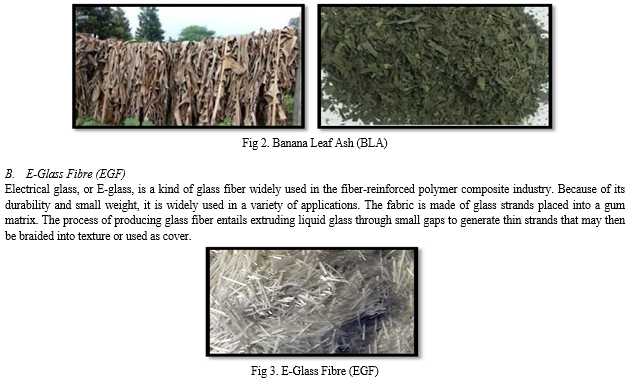
Table No 2. Physical properties of Banana Leaf Ash (BLA):
|
S.No |
Physical Property |
Banana Leaf Ash (BLA) |
|
1 |
Water absorption |
0.53 % |
|
2 |
Size of Particle |
Material passing through IS 90 microns |
|
3 |
Color |
Light Brownish |
|
4 |
Density |
1612 kg/m3 |
|
5 |
Modulus of Elasticity |
28.35 GPa |
|
6 |
Specific Gravity |
2.66 |
Table No 3. Physical properties of E-Glass Fibre (EGF):
|
S.No |
Physical Property |
E-Glass Fibre (EGF) |
|
1 |
Density |
2560 Kg/m3 |
|
2 |
Size of Particle |
12 microns |
|
3 |
Color |
Shiny White |
|
4 |
Modulus of Elasticity |
72 GPa |
|
5 |
Poisons Ratio |
0.26 |
|
6 |
Specific Gravity |
2.57 |
Table No 4. Chemical properties of Banana Leaf Ash (BLA) , E-Glass Fibre (EGF) & Cement:
|
S.No |
Chemical Composition |
OPC (%) |
BLA (%) |
EGF |
|
1 |
CaO |
40.83 |
27.45 |
20.23 |
|
2 |
SiO2 |
38.13 |
51.56 |
57.32 |
|
3 |
Al2O3 |
8.76 |
3.78 |
8.85 |
|
4 |
MgO |
1.55 |
1.35 |
5.11 |
|
5 |
SO3 |
2.25 |
1.98 |
- |
|
6 |
Fe2O3 |
2.67 |
5.01 |
- |
|
7 |
Misc |
5.81 |
8.86 |
8.49 |
C. Methodology
The Methodology describes the fill-ins used & mechanical attributes done over this paper:
- Understudy of both Banana Leaf Ash & E- Glass Fibre infused in Cement such that, with a fixed proportion of 3% EGF & a variable proportion from 2.5%-12.5% with frequency of 2.5% in cement as mentioned.
- Property check of Compressive Strength for cubes with a size of 150mm*150mm*150mm.
- Property check of Tensile Strength for cylinder with dimensions of 150mm diameter & 300mm Height.
- Property check of Bending Strength for Beam with a dimensions of 500mm*100mm*100mm
III. LITERATURE REVIEW
- Jennef C. Tavares; Luciana F.L. Lucena et.al; Construction and Building Materials Volume 346, 5 September 2022, 128467. The purpose of this study is to look at the usage of BLA as a partial replacement for Portland cement (PC) in green concrete. Concrete was made by substituting PC with BLA at levels of 0, 5, 10, and 15% of the binder weight, and its physical (composition, bulk density, dry density, moisture absorption rate) and mechanical characteristics were investigated. Properties. (Compressive strength). According to studies, adding BLA to concrete improves its physical and mechanical qualities while also increasing the replacement content by up to 10%. Microstructural research revealed that BLA may react with Ca(OH)2 produced during cement hydration, producing additional C-S-H and demonstrating the residue's pozzolanic strength. As a result, concrete containing BLA-10 increased material performance and research since it is ecologically benign for composite building. https://doi.org/10.1016/j.conbuildmat.2022.128467
- Nusrat Jahan Mim a, Md Montaseer Meraz et.al; Journal of Building EngineeringVolume 64, 1 April 2023, 105581. The high cement content and requirement for several additives in self-consolidating concrete (SCC) result in high yields but also significant cement consumption, which restricts its application in building. Thus, it is advisable to think about several approaches to create an efficient SCC while lowering the environmental influence. Thus, the goal of this work is to find the ideal BLA ratio by examining the mechanical, structural, and microbiological characteristics as well as the environmental impacts of self-compacting concrete (SCC) mixed with banana leaf ash (BLA). Investigated were concrete mixtures with 10%, 20%, and 30% OPC substitution. The test findings revealed that every novel combination performed within the parameters advised by EFNARC (2002). Though the mechanical characteristics deteriorated with increasing BLA concentration, BLA strength up to 20% produced strength comparable to that of the control mixture. Furthermore, the permeability of chloride ions rises up to 4%; 20% of BLA replenishment falls into the intermediate permeability zone. Lastly, the low global warming potential (GWP) is indicated by the low CO2-eq per MPa (up to 29.13% decrease).
https://doi.org/10.1016/j.jobe.2022.105581
3. A.J. Majumdar, R.W. Nurse Materials Science and Engineering Volume 15, Issues 2–3, August–September 1974, Pages 107-127 A novel composite material called glass fiber reinforced cement is brought to the market. It is composed of fine aggregate and cement or cement matrix, reinforced with a tiny amount of alkali-resistant glass fibers. The glass content is comparatively modest and is constrained as the glass content rises by mixing and compaction issues. There is an ideal glass content in relation to flexural strength for all mixing and placement techniques as well as mixing percentage modifications; impact strength improves steadily as glass content increases. An ingredient is needed for premixing; methylcellulose or polyethylene oxide are common choices. Press mixed formulations can be put into position via extrusion, pumping, or vibration and compaction. Mixing and placing the fiberglass stream from the spray cutter as a slurry and injecting it into the matrix at the same time is an efficient technique. The combined sprays are directed towards a suction mold, which eliminates surplus water. Properties of composites prepared by the various methods are compared. The impact strength and fire resistance of glass fibre reinforced cement are particularly good.
https://doi.org/10.1016/0025-5416(74)90043-3
4. Arife Yurdakul , Emrah Dolekcekic et.al; Construction and Building Materials Volume 170, 10 May 2018, Pages 13-19 The objective of this endeavor was the use of glass fibers of the SMFMZS system in a cement structure. First, commercially available E-glass fibers were used as a standard and incorporated into the cement structure to enhance the overall mechanical properties. In this investigation, commercially available high alkali glass fibers were used in the composite structure. When using commercial fibers with a polymer coating, the mechanical properties of the cement deteriorate due to the hydrophobicity of the silane coating on the glass fiber surface.
https://doi.org/10.1016/j.conbuildmat.2018.03.062

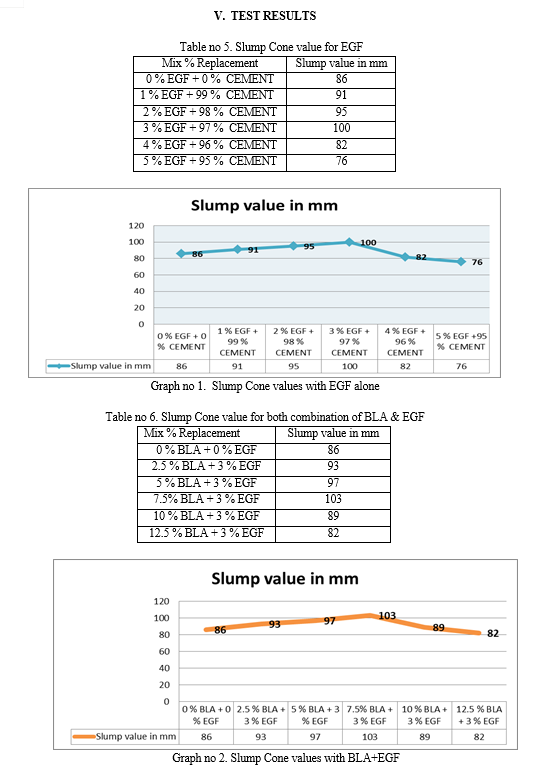


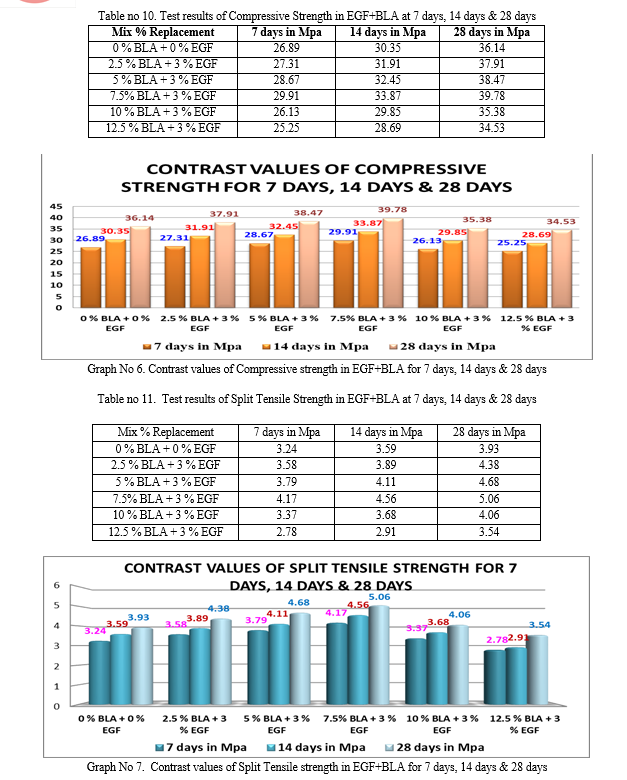
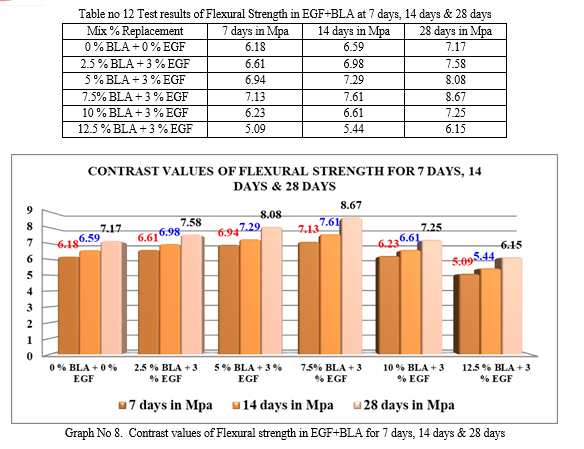
Conclusion
1) Finally my test results speaks about two important replacements done in cement like BLA & EGF with EGF as constant which is achieved max strength at 28 days there by keeping it as constant infused BLA in cement. 2) I achieved max compressive strength for 28 days with 3 % EGF + 97 % CEMENT as 38.46 MPa. 3) Similarly for Tensile & Flexure for 28 days what I found is with 3 % EGF + 97 % CEMENT as 4.12 MPa & 7.19 MPa. 4) After infused the cement with BLA +EGF my strength found to be increased. 5) The Max Compressive Strength I received for 28 days with 7.5% BLA + 3 % EGF like 39.78 MPa. 6) Similarly for Tensile & Flexure for 28 days what I found is with 7.5% BLA + 3 % EGF as 5.06 MPa & 8.67 MPa. 7) Comparatively I found the better results & progression in strength with BLA+EGF than EGF alone. 8) I suggest the BLA can be Replaced upto 7.5% & EGF upto 3% in Concrete. 9) The increase in compressive strength is about 3.43 % when compared with both BLA +EGF from EGF alone.
References
[1] Jennef C. Tavares; Luciana F.L. Lucena et.al; Construction and Building Materials Volume 346, 5 September 2022, 128467 .https://doi.org/10.1016/j.conbuildmat.2022.128467 [2] Nusrat Jahan Mim a, Md Montaseer Meraz et.al; Journal of Building Engineering Volume 64, 1 April 2023, 105581 https://doi.org/10.1016/j.jobe.2022.105581 [3] A.J. Majumdar, R.W. Nurse Materials Science and Engineering Volume 15, Issues 2–3, August–September 1974, Pages 107-127 https://doi.org/10.1016/0025-5416(74)90043-3 [4] Arife Yurdakul , Emrah Dolekcekic et.al; Construction and Building Materials Volume 170, 10 May 2018, Pages 13-19 https://doi.org/10.1016/j.conbuildmat.2018.03.062
Copyright
Copyright © 2024 Narla Sasikala, Vanam Sameer Kumar. This is an open access article distributed under the Creative Commons Attribution License, which permits unrestricted use, distribution, and reproduction in any medium, provided the original work is properly cited.

Download Paper
Paper Id : IJRASET63625
Publish Date : 2024-07-14
ISSN : 2321-9653
Publisher Name : IJRASET
DOI Link : Click Here
 Submit Paper Online
Submit Paper Online

